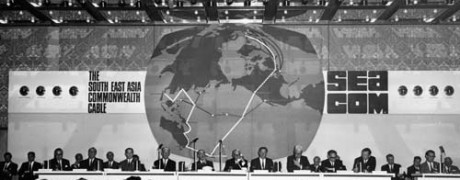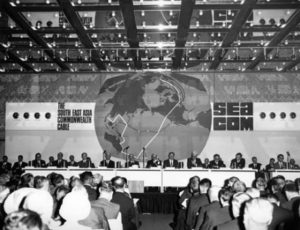
The CTO – a brief history
The Commonwealth Telecommunications Organisation (CTO) traces its origins to the creation of the Pacific Cable Board in 1901. In 1896, The Pacific Cable Committee had been formed to consider how the last element of a global electrical telegraph network connecting all parts of what was then the British Empire could be completed across the Pacific. By 1872, messages had been able to be sent from London to Adelaide or Sydney, and Australia had been linked to New Zealand by cable in 1876, but there was no connection across the Pacific to the west coast of Canada. Following the Committee’s deliberations, a Pacific Cable Board was created in 1901 consisting of eight members (three from Britain, two from Canada, two from Australia and one from New Zealand), and work commenced on laying the cable in 1902.
Subsequently, in 1928 the Imperial Communications Advisory Committee was formed to advise the British government on technical as well as international and Commonwealth issues. Chaired by a Cabinet Minister, it comprised members of the defence services, the Post Office and the Commonwealth. In 1944 this committee became renamed the Commonwealth Communications Council, and in 1949 it became the Commonwealth Telecommunications Board. This coincided with the London Declaration of 1949 which paved the way for a new kind of Commonwealth, based upon membership of the newly independent countries that had once been part of the British Empire.
Subsequent changes in the central organisation for the Commonwealth’s telecommunications sector closely reflected the growth and change of both the Commonwealth and also the telecommunications industry over the next fifty years. In 1965 an important Commonwealth Telecommunications Conference was held in London, which reconvened in 1966 and recommended that a new Commonwealth Telecommunications Organisation (CTO) should be established, consisting of a Council comprised of members of partner governments and a bureau based in London under the control and direction of the Council.
The first meeting of the CTO’s Council took place in 1967, and in 1968 the Commonwealth Telecommunications Act repealed the provisions relating to the Commonwealth Telecommunications Board, replacing these with provision for a new legal entity to be known as the Commonwealth Telecommunications Bureau which took over the old Board’s functions in 1969. In the same year a Commonwealth Telecommunications Organisation Financial Agreement was put in place to provide a new unified accounting mechanism for the organisation, and this was superseded by new agreements in 1973 and in 1983.
At its annual conference in 1992, member governments agreed to Council’s proposal that the scope of the organisation’s Programme for Development and Training (PDT) should be expanded, while terminating the CTO’s preferential adjustments under the Commonwealth Accounting Arrangements. Funding thereafter became a central issue of concern, and during the mid-1990s Australia and New Zealand withdrew from the organisation largely because of their concerns over proposals for financial contributions, with Canada subsequently withdrawing in 2001.
In its modern form, the CTO has therefore existed since 1967 as an international treaty organisation, independent of the Commonwealth Secretariat, and with diplomatic status in its host country, the UK. Its constitution was first agreed by Commonwealth Governments in Ottawa in 1972, and has been revised subsequently on various occasions. The current Constitution and the Rules of Procedure of the CTO came into force in 2012. The CTO is currently governed by its Council, with an Executive Committee overseeing the activities of the Secretariat between Council meetings. Formerly based in central London, its offices are now located to the west of the city in Hammersmith.


